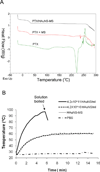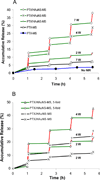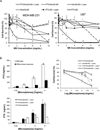Near-infrared light triggers release of Paclitaxel from biodegradable microspheres: photothermal effect and enhanced antitumor activity
- PMID: 20394071
- PMCID: PMC3435885
- DOI: 10.1002/smll.201000028
Near-infrared light triggers release of Paclitaxel from biodegradable microspheres: photothermal effect and enhanced antitumor activity
Abstract
Despite advances in controlled drug delivery, reliable methods for activatable, high-resolution control of drug release are needed. The hypothesis that the photothermal effect mediated by a near-infrared (NIR) laser and hollow gold nanospheres (HAuNSs) could modulate the release of anticancer agents is tested with biodegradable and biocompatible microspheres (1-15 microm) containing the antitumor drug paclitaxel (PTX) and HAuNSs (approximately 35 nm in diameter), which display surface plasmon absorbance in the NIR region. HAuNS-containing microspheres exhibit a NIR-induced thermal effect similar to that of plain HAuNSs. Rapid, repetitive PTX release from the PTX/HAuNS-containing microspheres is observed upon irradiation with NIR light (808 nm), whereas PTX release is insignificant when the NIR light is switched off. The release of PTX from the microspheres is readily controlled by the output power of the NIR laser, duration of irradiation, treatment frequency, and concentration of HAuNSs embedded inside the microspheres. In vitro, cancer cells incubated with PTX/HAuNS-loaded microspheres and irradiated with NIR light display significantly greater cytotoxic effects than cells incubated with the microspheres alone or cells irradiated with NIR light alone, owing to NIR-light-triggered drug release. Treatment of human U87 gliomas and MDA-MB-231 mammary tumor xenografts in nude mice with intratumoral injections of PTX/HAuNS-loaded microspheres followed by NIR irradiation results in significant tumor-growth delay compared to tumors treated with HAuNS-loaded microspheres (no PTX) and NIR irradiation or with PTX/HAuNS-loaded microspheres alone. The data support the feasibility of a therapeutic approach in which NIR light is used for simultaneous modulation of drug release and induction of photothermal cell killing.
Figures







Similar articles
-
Effects of Near-infrared Laser Irradiation of Biodegradable Microspheres Containing Hollow Gold Nanospheres and Paclitaxel Administered Intraarterially in a Rabbit Liver Tumor Model.J Vasc Interv Radiol. 2012 Apr;23(4):553-61. doi: 10.1016/j.jvir.2011.12.017. Epub 2012 Feb 15. J Vasc Interv Radiol. 2012. PMID: 22341633 Free PMC article.
-
Specific tumor delivery of paclitaxel using glycolipid-like polymer micelles containing gold nanospheres.Biomaterials. 2013 Jun;34(18):4510-9. doi: 10.1016/j.biomaterials.2013.02.069. Epub 2013 Mar 16. Biomaterials. 2013. PMID: 23510855 Free PMC article.
-
Near-infrared light-sensitive liposomes for the enhanced photothermal tumor treatment by the combination with chemotherapy.Pharm Res. 2014 Mar;31(3):554-65. doi: 10.1007/s11095-013-1180-7. Pharm Res. 2014. PMID: 24022681 Free PMC article.
-
Light-activatable gold nanoshells for drug delivery applications.AAPS PharmSciTech. 2014 Jun;15(3):741-52. doi: 10.1208/s12249-014-0097-8. Epub 2014 Feb 19. AAPS PharmSciTech. 2014. PMID: 24550102 Free PMC article. Review.
-
Recent near-infrared light-activated nanomedicine toward precision cancer therapy.J Mater Chem B. 2021 Sep 15;9(35):7076-7099. doi: 10.1039/d1tb00671a. J Mater Chem B. 2021. PMID: 34124735 Review.
Cited by
-
The golden age: gold nanoparticles for biomedicine.Chem Soc Rev. 2012 Apr 7;41(7):2740-79. doi: 10.1039/c1cs15237h. Epub 2011 Nov 22. Chem Soc Rev. 2012. PMID: 22109657 Free PMC article. Review.
-
Water-soluble L-cysteine-coated FePt nanoparticles as dual MRI/CT imaging contrast agent for glioma.Int J Nanomedicine. 2015 Mar 23;10:2325-33. doi: 10.2147/IJN.S75174. eCollection 2015. Int J Nanomedicine. 2015. PMID: 25848253 Free PMC article.
-
Ultrasensitive Phototriggered Local Anesthesia.Nano Lett. 2017 Feb 8;17(2):660-665. doi: 10.1021/acs.nanolett.6b03588. Epub 2017 Jan 6. Nano Lett. 2017. PMID: 28058845 Free PMC article.
-
Tumor cell membrane-camouflaged responsive nanoparticles enable MRI-guided immuno-chemodynamic therapy of orthotopic osteosarcoma.Bioact Mater. 2022 Jan 26;17:221-233. doi: 10.1016/j.bioactmat.2022.01.035. eCollection 2022 Nov. Bioact Mater. 2022. PMID: 35386464 Free PMC article.
-
Smart polymers for the controlled delivery of drugs - a concise overview.Acta Pharm Sin B. 2014 Apr;4(2):120-7. doi: 10.1016/j.apsb.2014.02.005. Epub 2014 Mar 24. Acta Pharm Sin B. 2014. PMID: 26579373 Free PMC article. Review.
References
-
- Perelman LA, Pacholski C, Li YY, VanNieuwenhze MS, Sailor MJ. Nanomed. 2008;3:31. - PubMed
-
- Lai CY, Trewyn BG, Jeftinija DM, Jeftinija K, Xu S, Jeftinija S, Lin VSY. J. Am. Chem. Soc. 2003;125:4451. - PubMed
-
- Meers P. Adv. Drug Deliver. Rev. 2001;53:265. - PubMed
-
- Ankareddi I, Hampel ML, Sewell MK, Kim D-H. Nanotech. 2007;2:431.
Publication types
MeSH terms
Substances
Grants and funding
LinkOut - more resources
Full Text Sources
Other Literature Sources
Miscellaneous

